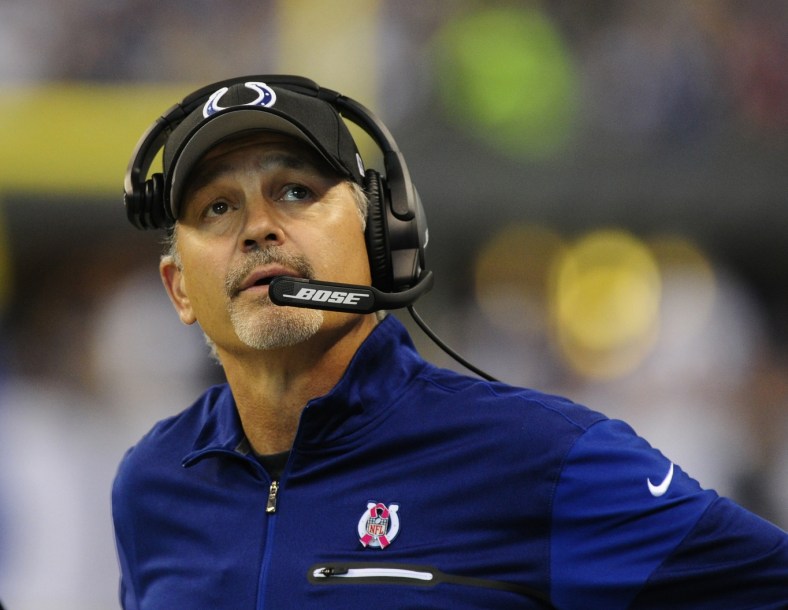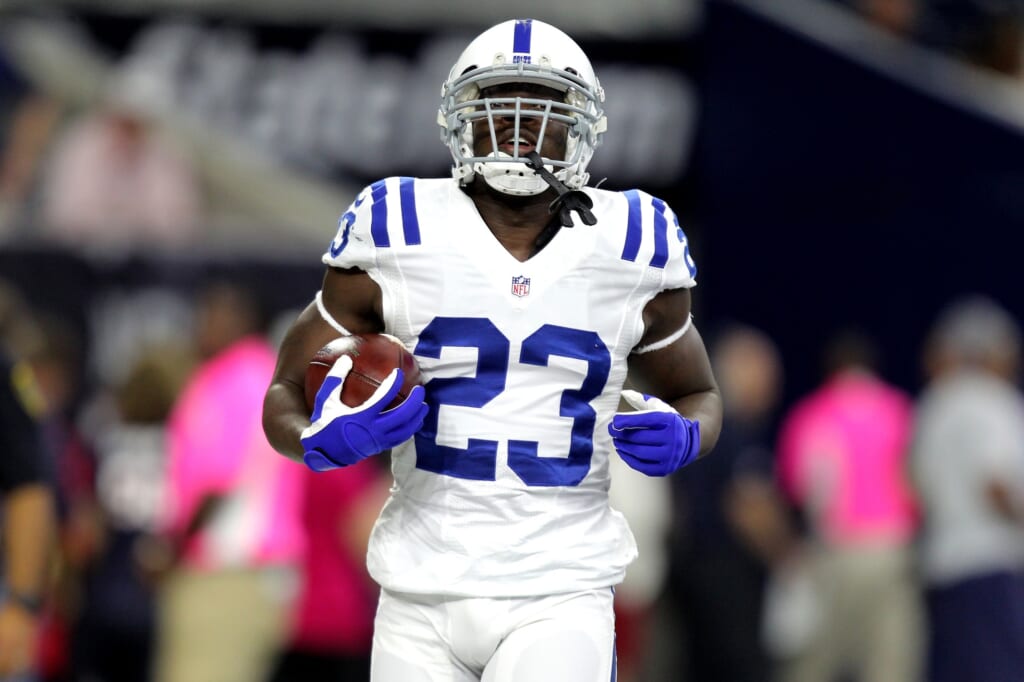
At the bottom of the AFC South, there is a grand football experiment happening. On one hand, the Indianapolis Colts have one of the best quarterbacks in the league paired with a terrible supporting cast. On the other, the Jacksonville Jaguars have one of the worst quarterback situations in the league paired with a great supporting cast. Neither team figures to be especially good thanks to their deficiencies, but their seasons will act as a treatise on just how important the quarterback position is to a team’s success.
We project the Colts to finish last, not just because of the 52 players (and coaching staff) around Andrew Luck, but also because Luck will not play 16 games. His status for Week 1 appears to be a no-go, especially given the fact his coach has yet to see him throw a single pass. When Luck does eventually return, he’ll be great. Last season, he singlehandedly dragged the Colts to an 8-8 record, throwing for 4,240 yards and ranking 10th among quarterbacks in DYAR. Luck also finished fifth in accuracy percentage, per Cian Fahey’s charting, with 79.02 percent of his throws being on target. If only the rest of the offense was half as good.
Luck’s receivers accounted for 56 failed receptions and 559 lost yards last season, per Fahey, worse than only two teams in either category. This despite T.Y. Hilton quietly putting up a league-leading 1,448 receiving yards. Hilton is one of the only players other than Luck on this team who would not just start, but be a featured part of any other team in football. He ranked fourth among receivers in DYAR and 12th in DVOA, averaging 15.9 yards per reception as well.

After Hilton, things start to drop off very fast. Donte Moncrief had trouble staying healthy last season, playing just nine games. However, Moncrief was fairly underwhelming when he played, going for just 307 yards on 30 catches. He also had a paltry -1.9 percent DVOA, which ranked 58th among receivers. Phillip Dorsett figures to be the No. 3 wideout, but he has failed to make much of an impact over his first two seasons. Despite playing 15 games to Moncrief’s nine, Dorsett caught just three more balls than his teammate. At 16.0 yards per reception, Dorsett could see a steady diet of deep balls, if the pocket is clean long enough for him to get downfield.
The offensive line is one of the worst pass blocking units in the league, bar none. The Colts were 28th in adjusted sack rate and 31st in pressure rate last season, per Football Outsiders’ Almanac. Left tackle Anthony Castonzo — the line’s best player by PFF grading — blew 16 pass blocks last season, per FOA. Across from him, right tackle Le’Raven Clark played just eight games in his rookie year but had a 42.3 pass blocking grade from PFF. On the interior, right guard Denzelle Good allowed 5.5 sacks and blew 12 pass blocks, per FOA. Good’s 41.6 PFF grade also ranked 66th among guards. Center Ryan Kelly and left guard Jack Mewhort were the only two reliable players on the line when it came to pass protection last year, allowing just 1.5 sacks between them last year, per FOA. However, Kelly will miss a healthy chunk of the season with a foot injury, so Brian Schwenke will be at center instead. Schwenke had a 52.7 PFF grade last season, so he’ll be a fairly big downgrade on a unit that couldn’t afford one. The line was somehow very good at run blocking last season, finishing third in adjusted line yards. No player blew more than three run blocks last season either, per FOA. That feels like a statistical anomaly, but the run game was decent last season.
Frank Gore is getting up there at age 34, but the future Hall of Famer was solid last year. Gore finished 12th among running backs in DYAR and ran for over 1,000 yards. There were some signs of wear — he averaged under four yards per carry for the second straight year — but Gore hasn’t fallen off a cliff by any means.

Head coach Chuck Pagano may be the biggest detriment to the offense. Pagano should have been fired a long time ago, yet somehow retains his job even after front office shakeups. It would be surprising to see him last the year given that he wasn’t new GM Chris Ballard’s hire. But he’s somehow lasted this long, so anything could happen. Pagano’s biggest problem is that he doesn’t adjust to what he sees on the field, or even what is painfully obvious to the average fan. When Luck was getting dinged every time he dropped back last season, Pagano refused to work in more horizontal routes. Instead, he forced Luck to stand in the pocket and throw vertically, blaming Indy’s offensive troubles on a failure to establish the run — a theory long proven to be false. His presence will make an already bad Colts team even worse.
Defensively, the Colts were 29th in DVOA last season and things could get worse before they get better. The only major addition the team made in free agency was defensive tackle Johnathan Hankins, who will likely play nose tackle in Indy’s 3-4. Hankins won’t do much when it comes to rushing the passer, but he is a great run defender. He had a 79 percent run stop rate last season, per FOA, despite Damon Harrison forcing him out of his natural position in New York. At defensive end, Henry Anderson is one of the better draft picks Ryan Grigson made as general manager of the Colts. His 83 percent run stop rate ranked 26th at the position last season. Opposite him, the job looks like it will be Hassan Ridgeway’s. A fourth round pick in 2016, Ridgeway had a terrible 51.3 PFF grade. However, he did flash some potential as a run defender, posting an 88 percent stop rate over a small sample size, per FOA.
At outside linebacker, Jabaal Sheard and John Simon look like the two best pass rushers on this team. The two combined for just 7.0 sacks last season with the Patriots and Texans. Sheard also had four hits and 26 hurries, per FOA, with Simon putting up six hits and 13 hurries. Both of these guys are fine, but neither should be forced to carry a load. The Colts were dead last in pressure rate on the defense last season, per FOA, and without a breakout year from one of these two, that won’t change.
Expect Akeem Ayers to see time at outside linebacker as well. The 28-year old had a 75 percent run stop rate last year, though he didn’t make much of an impact as a pass rusher. Newly acquired Margus Hunt could be in the rotation too.
On the inside, Sean Spence gives the Colts a solid coverage linebacker. He had a 55 percent success rate and gave up just 6.0 adjusted yards per target last season, according to FOA. Both numbers ranked inside the top 30 among linebackers. Next to him, Edwin Jackson may highlight just how much the Colts needed a solid coverage linebacker. Jackson had a 44 percent success rate last year, per FOA, along with a 47.2 PFF grade. 2016 fourth rounder Antonio Morrison will be in the mix as well after struggling through his rookie season. Anthony Walker Jr., a fifth-round pick this season, will also get snaps.
The Colts did take steps to rebuild the secondary, spending their first and second round picks on a safety and corner. However, it’s still a fairly ragtag group.

If cornerback Vontae Davis bounces back after an injury-riddled season, it would be a godsend. Davis, despite his injuries, was still inside the top-20 in success rate last year, per FOA, a positive sign for the future. Second-round pick Quincy Wilson has a lot of potential, but it may take him a while to develop. Wilson was an extremely physical corner in college, almost to a fault. He has loose hips and should instantly be able to play press coverage at an NFL level. However, the Florida product isn’t especially athletic and has a penchant to gamble. Expect teams to attack and win by going inside on him until Wilson finds a way to combat it. At nickel back, Darryl Morris played just 360 snaps last season but had a 43 percent success rate, per FOA. Rashaan Melvin and Darius Butler will get playing time at corner as well. Melvin struggled last year with just a 46 percent success rate last year, per FOA. However, Butler posted good numbers, including an 80.0 PFF grade.
At safety, first-round pick Malik Hooker has the tools to be a great player for a long time. He’s springy, athletic and fast as lightning. The Ohio State product has good ball skill and hip fluidity as well. Once Hooker develops further, he could play as a single-high safety on one snap and cover a tight end man-to-man on the next. Right now, the two biggest things that need to change in Hooker’s game are tackling and over-aggressiveness. Hooker missed 13 tackles last season, per PFF, a trait that will bite him in run defense especially. And while aggressiveness is generally a good thing, Hooker crosses the line into gambling a little too often. That being said, he should be a reliable player as soon as this year.
Next to him, T.J. Green will get the bulk of the snaps with Clayton Geathers starting the year on the PUP list. Green struggled badly last season, with a paltry 39 percent success rate, per FOA, and 32.5 PFF grade. If those continue, Darius Butler could take the job. Assuming Geathers returns at some point, the Colts may have a respectable duo at safety by the end of the year. Geathers was just outside the top 25 in PFF grading with an 81.3 mark and was one of the better run defenders at the position last year. Some marks of progress are small, but they’re progress nonetheless.
Between bad health, bad coaching, bad defense and a bad supporting cast, the Colts look cooked for this season.
The focus right now should be on building back up — especially on defense — into something that resembles a championship contender for 2018. As long as Luck is under center, Indy has a chance in any game, but “surround Andrew Luck with terrible players,” is a plan that doesn’t work in the long run, something the Colts learned the hard way.
If you would like to learn more about the advanced stats we used, check out FootballOutsiders.com, which is largely free, or ProFootballFocus.com which is not.